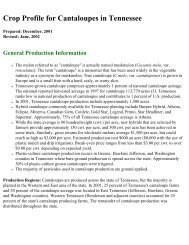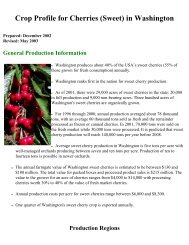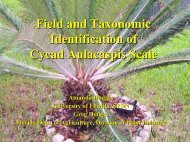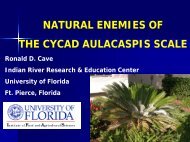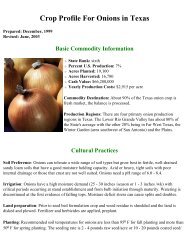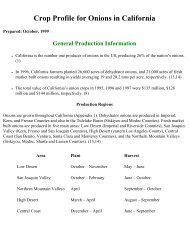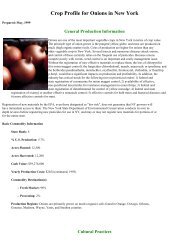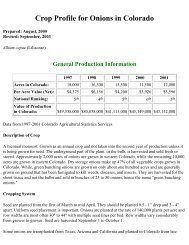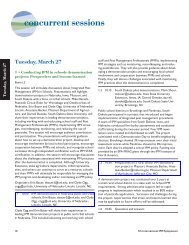Crop Profile for Strawberries in California - Regional IPM Centers
Crop Profile for Strawberries in California - Regional IPM Centers
Crop Profile for Strawberries in California - Regional IPM Centers
You also want an ePaper? Increase the reach of your titles
YUMPU automatically turns print PDFs into web optimized ePapers that Google loves.
Monitor<strong>in</strong>g. When monitor<strong>in</strong>g <strong>for</strong> other pests, growers watch <strong>for</strong> evidence of looper feed<strong>in</strong>g: leaflets<br />
with holes, feces, and caterpillars feed<strong>in</strong>g at the edge of a hole. If larvae are larger <strong>in</strong>stars, an<br />
organophosphate may be needed to control them.<br />
Cultural:<br />
Controls<br />
● Placement of Fields Relative to Other <strong>Crop</strong>s. Cabbage looper has only recently become a pest<br />
<strong>in</strong> strawberries planted next to lettuce fields. Select<strong>in</strong>g a strawberry field that is not adjacent to a<br />
host crop <strong>for</strong> cabbage looper is one way to control <strong>in</strong>festations, although this practice has become<br />
less practical due to rotation with vegetable growers.<br />
Biological:<br />
● Parasitic Wasps. Loopers are sometimes controlled by the parasitic wasps Hyposoter exiguae,<br />
Copidosoma truncatellum, and Trichogramma spp.<br />
● Natural Virus. A natural outbreak of nuclear polyhedrosis virus also sometimes provides control<br />
of the looper population.<br />
Chemical:<br />
● Bacillus thur<strong>in</strong>giensis. 0 day PHI. Bacillus thur<strong>in</strong>giensis (Bt) is applied at label rates to<br />
approximately 0.1 lb ai/acre on to about 30% of the strawberry acreage. Applications are made<br />
when plants are dry, and good coverage at relatively low dilution rates is essential to product<br />
per<strong>for</strong>mance. Treatments are made when armyworms are still small. To be effective it must be<br />
applied no later than the second <strong>in</strong>star. Bt is acceptable <strong>for</strong> use on organically grown produce.<br />
The restricted-entry <strong>in</strong>terval <strong>for</strong> Bt is 4 hours.<br />
● Diaz<strong>in</strong>on. 5 days PHI. Diaz<strong>in</strong>on is applied to strawberry fields at a rate of 0.8 lb ai/acre.<br />
Diaz<strong>in</strong>on is not used unless loopers pose a serious threat to the crop. Diaz<strong>in</strong>on is harmful to mite<br />
predators and outbreaks of twospotted spider mites may occur follow<strong>in</strong>g its use. Diaz<strong>in</strong>on is used<br />
to treat around 8% the state's strawberry acres. The restricted-entry <strong>in</strong>terval <strong>for</strong> diaz<strong>in</strong>on is 24<br />
hours.<br />
● Chlorpyrifos. 21 day PHI. Chlorpyrifos (LORSBAN) is an broad-spectrum <strong>in</strong>secticide applied at<br />
an average rate of 1 lb ai/acre to approximately 15% of strawberry acreage. Applications are<br />
typically made pre-bloom. Chlorpyrifos provides economic control but kills beneficial and<br />
nontarget organisms. The restricted-entry <strong>in</strong>terval <strong>for</strong> chlorpyrifos is 24 hours.<br />
● Methomyl. 3 day PHI <strong>for</strong> fresh and 10 day PHI <strong>for</strong> process<strong>in</strong>g strawberries. Methomyl



